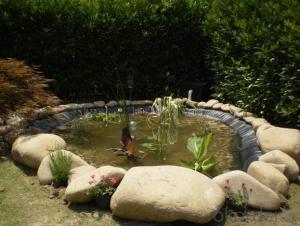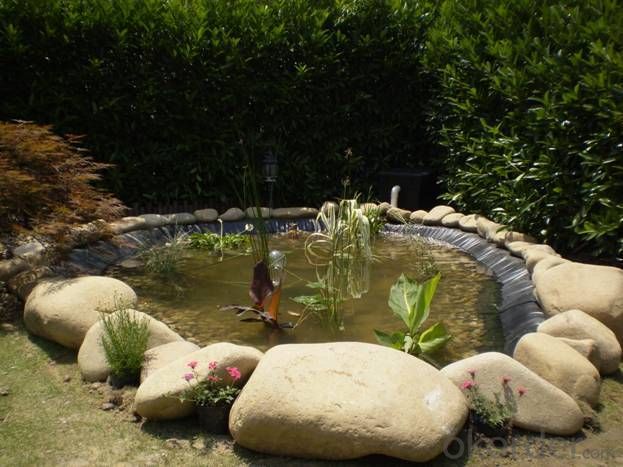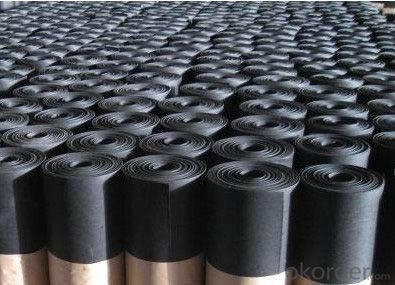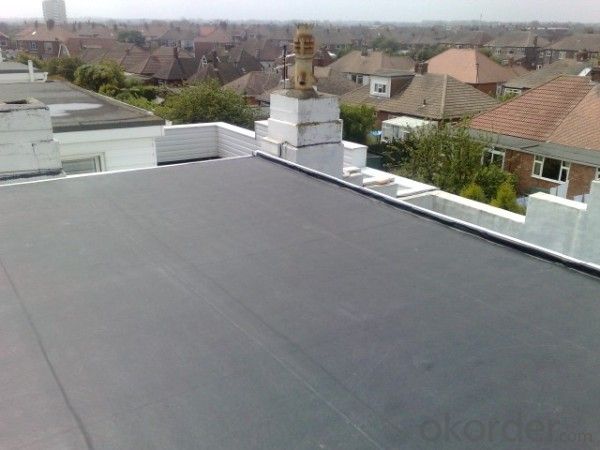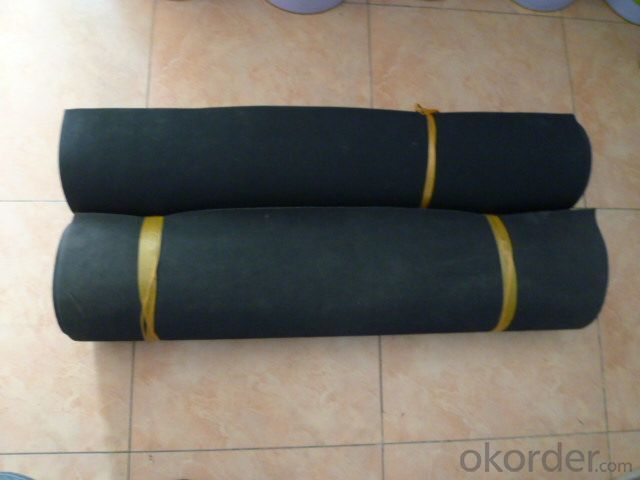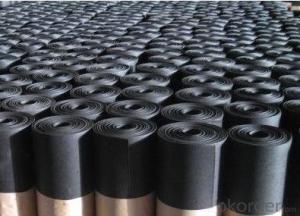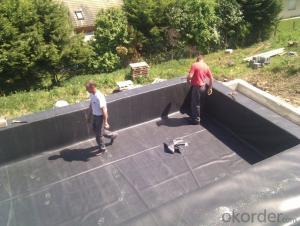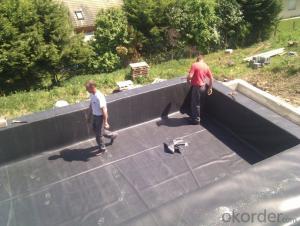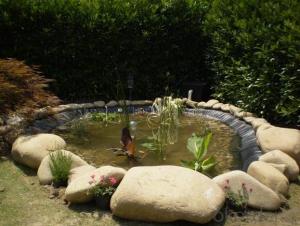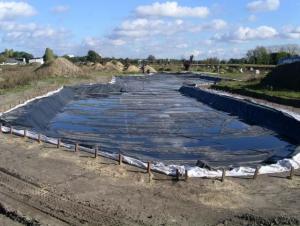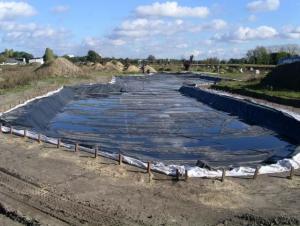EPDM Coiled Rubber Waterproof Membrane for Manmade Pond
- Loading Port:
- Shanghai
- Payment Terms:
- TT OR LC
- Min Order Qty:
- 50000 m²
- Supply Capability:
- 5000000 m²/month
OKorder Service Pledge
OKorder Financial Service
You Might Also Like
EPDM Coiled Rubber Waterproof Membrane for Manmade Pond
Description Of EPDM Coiled Rubber Waterproof Membrane for Manmade Pond:
•EPDM waterproof sheet has excellent anti-ozone-aging performance, able to resist ultraviolet light and corrosion of many chemical corrosive materials in the atmosphere
•It has high tensile strength, high ductility and strong retractility, it has excellent crack resistance, able to effect waterproof function even with tiny vibration of buildings.
• Excellent resistance to ozone, oxidation and sunlight.
• Resistance to chemicals; resistant to most inorganic products.
Main Features of EPDM Coiled Rubber Waterproof Membrane for Manmade Pond:
A.Polyester based SBS Modified Bitumen Waterproofing Membrane
a. Strong impermeability
b. High tensile strength, elongation, ability to adapt the grassroots shrinkage deformation and cracking
c. Puncture-resistant, broken resistant, tear-resistant
d. The corrosion resistance, resistance to mildew, weathering good
e. Construction convenient, hot-melt can be operated Four Seasons Construction, reliable joints
Specifications of EPDM Coiled Rubber Waterproof Membrane for Manmade Pond:
| Material | EPDM Rubber |
| Size | 1.2m (width)*20m (length) or customized, weldable type 2.05m or 4m width |
| Thick | 1.2mm, 1.5mm, 2.0mm |
| Type | Vulcanized & Weldable |
| Pattern | Non-reinforced (homogeneous) |
| Certificate | ISO9001/14001 |
Applications of EPDM Coiled Rubber Waterproof Membrane for Manmade Pond:
1. The substratum should be smooth, dry, clean, which can not have loosing and peeling phenomena.
2. Before application, clean up the basic level and eradicate the impurities.
3. Spread out the membrane on the substratum to loose sheet's stress. Use adhesive-glue to paint the substratum and the surface of membrane. When the adhesive is not sticky to hands, pave and press smoothly.
4. When pave the second volume of membrane, extrude 100mm of the edge of overlap of the first roll and do not paint with the adhesive. Pave the membrane on the substratum according to step so as to finish the whole pavement. When paving, do not tighten the waterproof membrane violently.
5. After that, use the special solvent to scrub the overlap joint. When it becomes fully dry , use the sheet glue to paint the both sides of the joint. Paint it again when it gets completely dry. Till the adhesive is not sticky to hands, press it smoothly and solidly.
6. Pay attention to fire prevention during application. Basement construction site shall be equipped with ventilation facilities



IMages of EPDM Coiled Rubber Waterproof Membrane for Manmade Pond:




FAQ of EPDM Coiled Rubber Waterproof Membrane for Manmade Pond:
1. What are we supplying?
We are specialized in producing Colorful Asphalt Roof Shingle, SBS/APP modified bitumen waterproof membrane, Self adhesive bitumen waterproof membrane, PVC waterproofing membrane, EPDM rubber roofing membrane, Single Component Polyurethane Waterproof Coating, and Spray Polyurea Waterproof Coating
.
2. How Many years experience do we have?
We have been exported to more than 20 countries in the past 15 years.
3. How long do we usually reply your request?
We always reply our customer within 24 hours.
- Q: Is a waterproofing membrane resistant to rodent or insect infestation?
- Yes, a waterproofing membrane is typically resistant to rodent or insect infestation. The membrane acts as a physical barrier, preventing pests from accessing the underlying structure. However, it is important to ensure proper installation and maintenance to minimize any potential vulnerabilities that could be exploited by pests.
- Q: Does a waterproofing membrane require any specific safety precautions during installation?
- Yes, installing a waterproofing membrane does require specific safety precautions. Here are some key precautions to consider: 1. Personal Protective Equipment (PPE): Installers should wear appropriate PPE, including gloves, safety glasses, and protective clothing to prevent skin contact with the membrane and any potential chemical hazards. 2. Adequate Ventilation: Ensure the installation area is well-ventilated to prevent the buildup of fumes or vapors. If working in an enclosed space, use proper ventilation systems to remove any potentially harmful gases or odors. 3. Hazardous Chemicals: Some waterproofing membranes may contain hazardous chemicals or solvents. Installers should carefully read and follow the manufacturer's instructions for handling and using these products. Proper storage, handling, and disposal of chemicals should be observed to avoid accidents or environmental contamination. 4. Slips and Falls: During installation, the surface can become slippery, especially if the membrane is applied on wet surfaces. Installers should take precautions to secure their footing and use appropriate safety equipment like harnesses or guardrails when working at heights to prevent falls. 5. Heat Hazards: Some waterproofing membranes require the use of heat for proper installation. Installers should take precautions when working with heat sources like torches or heat guns to prevent burns or fire hazards. Fire extinguishers should be readily available, and proper training on fire safety protocols is essential. 6. Electrical Safety: Waterproofing membranes may be installed in areas where electrical systems are present. Installers should be cautious when working near live electrical wires or outlets and follow proper electrical safety procedures to prevent electric shocks or fires. It is important for installers to receive proper training and follow all safety guidelines provided by the manufacturer to minimize the risk of accidents, injuries, or property damage during the installation process.
- Q: Can a waterproofing membrane be used on concrete bridges?
- Yes, a waterproofing membrane can be used on concrete bridges. Waterproofing membranes are commonly utilized in infrastructure projects, including concrete bridges, to protect the structure from water penetration and damage. These membranes create a barrier that prevents water from seeping into the concrete, thus enhancing the durability and longevity of the bridge.
- Q: Can a waterproofing membrane be used on modified bitumen roofs?
- Yes, a waterproofing membrane can be used on modified bitumen roofs. In fact, it is a common practice to install a waterproofing membrane over modified bitumen roofs to provide an additional layer of protection against water infiltration. This is especially important in areas with heavy rainfall or where the roof is prone to frequent exposure to water. The waterproofing membrane helps to seal any potential cracks or gaps in the modified bitumen roofing system, preventing water from seeping through and causing damage to the underlying structure. Additionally, the waterproofing membrane can also enhance the overall durability and longevity of the roof by protecting it from the harmful effects of moisture.
- Q: Can a waterproofing membrane be used for stadiums or sports fields?
- Stadiums or sports fields can benefit from the use of a waterproofing membrane. This type of membrane is commonly employed in construction projects to safeguard the underlying structure from moisture damage and prevent water infiltration. Given that stadiums and sports fields are constantly exposed to various elements, such as rain, snow, and irrigation, a waterproofing membrane serves as an effective solution to protect the foundation and other structural elements from water damage. Additionally, it maintains the integrity and durability of the playing surface, preventing issues like unevenness, soft spots, or slippery conditions caused by water seepage. In conclusion, the utilization of a waterproofing membrane is instrumental in enhancing the performance and longevity of stadiums and sports fields, as it acts as a moisture barrier.
- Q: Can a waterproofing membrane be used in conjunction with solar panel installations?
- Yes, a waterproofing membrane can be used in conjunction with solar panel installations. Waterproofing membranes are commonly used to protect roofs and other surfaces from water damage, and they can provide an additional layer of protection for solar panels. This can help to prevent water infiltration and potential damage to the solar panels and their electrical components. Additionally, waterproofing membranes can also help to extend the lifespan of the solar panel system by providing an extra barrier against moisture and other environmental factors.
- Q: Can a waterproofing membrane be used in residential construction?
- Residential construction can indeed utilize a waterproofing membrane. These membranes find common usage in different parts of a residential property, such as roofs, basements, bathrooms, and foundations. Their purpose is to prevent water from penetrating and causing damage due to moisture. By opting for a waterproofing membrane, homeowners can ensure that their property remains dry and free from water leaks. This is crucial because such leaks can result in mold growth, structural deterioration, and other costly problems. The market offers a variety of waterproofing membranes, such as sheet membranes, liquid membranes, and self-adhering membranes, each with its own advantages and suitability for specific applications. Consulting with a professional contractor or architect can assist in determining the most suitable waterproofing membrane for a particular residential construction project.
- Q: How to distinguish the degree of sbs waterproofing membrane?
- Method 2: send the laboratory to do low-temperature flexible test. With the eyes and hand pull and other methods can not judge, if the experienced SBS production technology staff, from the hand pull, bending and other methods to determine the initial performance.
- Q: Can a waterproofing membrane be used for water tanks and reservoirs?
- Water tanks and reservoirs can benefit from the use of a waterproofing membrane. These membranes are specifically designed to create a barrier against water penetration, making them an excellent choice for safeguarding against leaks and seepage. They are typically made of durable materials like modified bitumen, PVC, EPDM, or TPO, which are resistant to water and capable of enduring extended exposure to moisture. By applying a waterproofing membrane to the walls and floors of water tanks and reservoirs, a seamless and watertight seal is created, effectively preventing water loss or contamination. Moreover, these membranes can be tailored to fit different types of water tanks and reservoirs, guaranteeing a perfect fit and optimal protection. In conclusion, the use of a waterproofing membrane is a reliable and effective solution for preserving the integrity of water tanks and reservoirs and ensuring the safe storage of water.
- Q: Can a waterproofing membrane be used in historic buildings?
- Yes, a waterproofing membrane can be used in historic buildings. Historic buildings often face challenges related to moisture infiltration and water damage due to their age and construction materials. Waterproofing membranes are a common solution to prevent water seepage and protect the building's structural integrity. However, it is important to choose a waterproofing membrane that is compatible with the historic building's materials and construction methods to ensure its preservation and adherence to historical authenticity. Additionally, any waterproofing work done on a historic building should be carried out by professionals with expertise in historic preservation to ensure proper installation and minimal impact on the building's historical value.
Send your message to us
EPDM Coiled Rubber Waterproof Membrane for Manmade Pond
- Loading Port:
- Shanghai
- Payment Terms:
- TT OR LC
- Min Order Qty:
- 50000 m²
- Supply Capability:
- 5000000 m²/month
OKorder Service Pledge
OKorder Financial Service
Similar products
Hot products
Hot Searches
Related keywords
